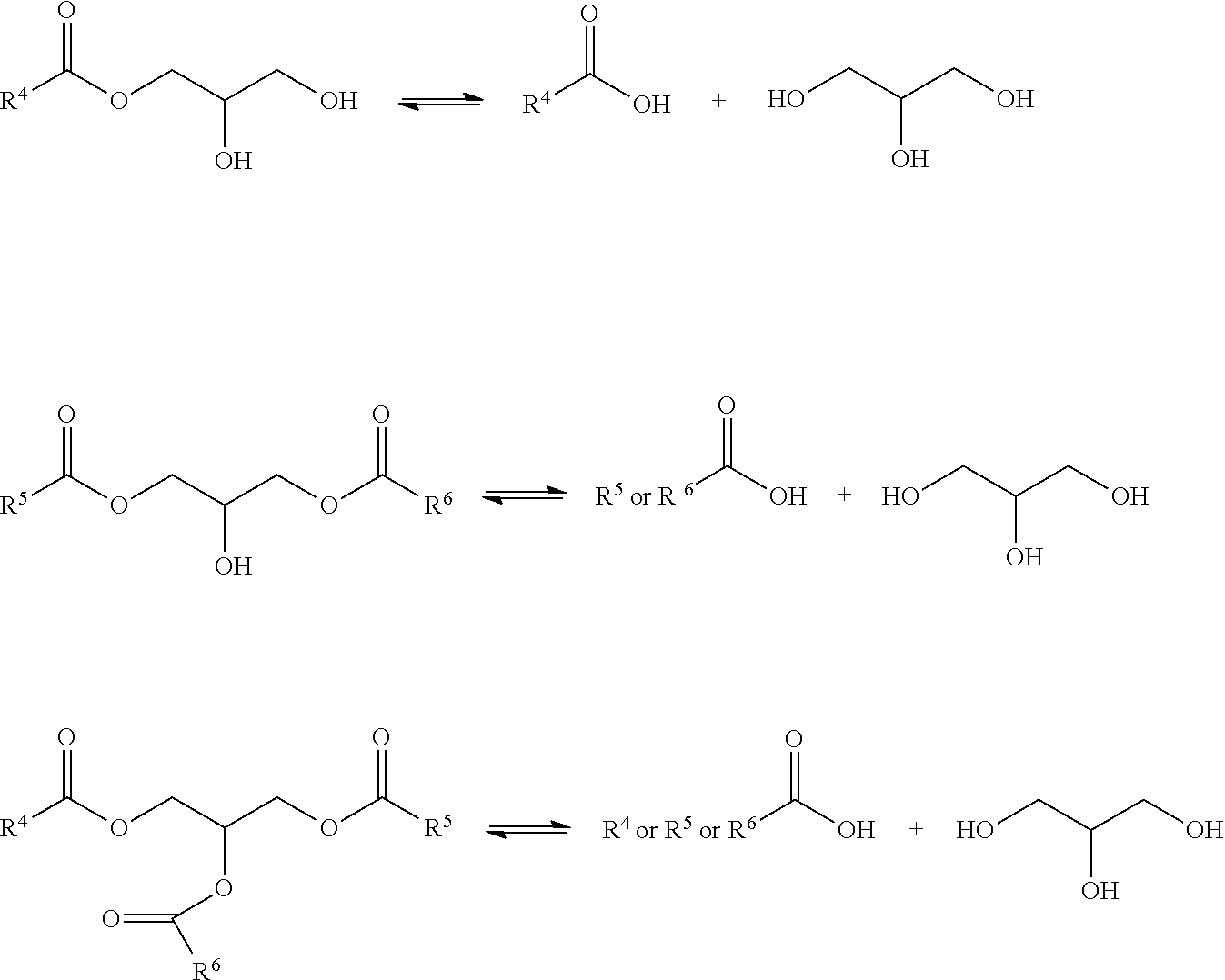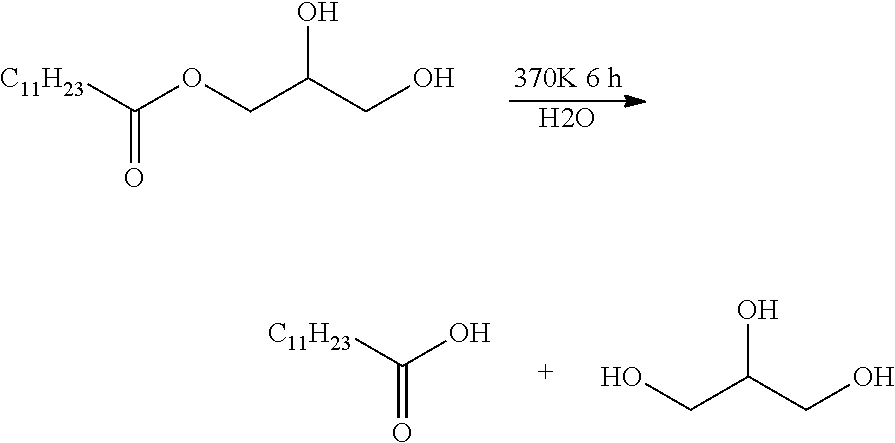Hydrolysis of an ester compound
- Summary
- Abstract
- Description
- Claims
- Application Information
AI Technical Summary
Benefits of technology
Problems solved by technology
Method used
Image
Examples
Example
Example 1
Propyl and Sulfonic Acid-Grafted Silica Nanoparticles
1.1 Grafting of Propyl and Mercapto Functions
[0104]Aerosil 200 (0.5 g) from Evonik Degussa was placed in a round flask, and then cyclohexane (50 mL) was added. The mixture was stirred until homogenous distribution of Aerosil 200. Then, different amount of silanes [20%: 0.4 mL of (OMe)3Si(CH2)3SH and 1.5 mL of (OMe)3Si(CH2)3] were added and stirred in flask, respectively. Then, 4-toluene sulfonic acid (0.0033 g) was added. The flask was placed on a pre-heated hotplate at 120° C. and the mixture was stirred for 4 hours. After cooling down to room temperature, the mixture was filtrated or centrifuged and washed by cyclohexane and ethanol for several times in order to remove 4-toluene sulfonic acid and unreacted silanes. The obtained samples were heated at 100° C. overnight.
1.2 H2O2 Oxidation
[0105]The above samples were placed in a round flask. H2O2 (30 wt %, m(H2O2):m(sample)=60:1) was added into flask and the mixtures were ...
Example
Example 2
Co-Precipitated Silica Nanoparticles Functionalized by Octadecyl and Sulfonic Acid Groups
[0107]A solution of ammonium hydroxide (NH3.H2O) (16.2 ml, 25˜28%) in absolute ethanol (200 ml) and bi-distilled water (28 ml) was firstly prepared in 40° C. for 10 minutes. A solution of TEOS (9.3 g) in ethanol (9.3 g) was added dropwise with vigorous stirring in the first solution. After about 5 minutes of pre-hydrolysis of TEOS, octadecyl silane ((OMe)3Si(CH2)17CH3) and SH-siliane were added in succession with a delay of 5 minutes. The TEOS / organosilanes molar ratio is 80 / 20, with C18 silane / SH silane molar ratio of 4. After 30 minutes, the white precipitation was separated by centrifugation at 8,000 rpm for 15 minutes. The obtained solids were washed with and centrifuged several times until that the suspended solution was neutral. The oxidation of —SH to —SO3H in samples was oxidized by H2O2 in the same condition as the above method. Finally, samples were treated by acid wash same a...
Example
Example 3
Esterolysis of Monolaurylglyceryl Ester by Several Catalysts
Reaction:
[0108]
[0109]Silica nanoparticles bearing alkyls and alkyl sulfonic aid have been used to catalyse the hydrolysis reaction of monolaurylglyceryl ester. Conversions and reaction conditions were listed in Table1.
TABLE 1CatalystCatalystEster / H2OTemp / Catalyst(weight %)(molar %)(weight)TimeConversionTONTFA1.1% 2%2:170° C. / 5 h 36.1%17SA0.73% 2%2:1100° C. / 5 h 37.1%18PTSA1%16.9% 1:395° C. / 11 h52.9%32SiO2 20 / 802%0.0116% 1:395° C. / 11 h 6%496SO3H / C310% 0.0519% 1:395° C. / 11 h48.7%886SiO2 20 / 804%0.0151% 1:395° C. / 11 h22.5%1403SO3H / C18SiO2 20 / 802% particles0%1:395° C. / 11 h 0.6%NASH / C3PTSA + SiO21%, 2%16.9% 1:395° C. / 11 h57.1%3220 / 80 SH / C3NH4Cl + SiO21%, 2%0%1:395° C. / 11 h 2.3%NA20 / 80 SH / C3
[0110]TFA is CF3SO3H. SA is H2SO4. PTSA is CH3C6H4SO3H
[0111]Catalyst (weight %) corresponds to the weight amount of catalyst to the weight amount of ester. Catalyst (molar %) corresponds to the molar amount of catalyst acid s...
PUM
| Property | Measurement | Unit |
|---|---|---|
| Temperature | aaaaa | aaaaa |
| Time | aaaaa | aaaaa |
| Time | aaaaa | aaaaa |
Abstract
Description
Claims
Application Information
 Login to View More
Login to View More - R&D
- Intellectual Property
- Life Sciences
- Materials
- Tech Scout
- Unparalleled Data Quality
- Higher Quality Content
- 60% Fewer Hallucinations
Browse by: Latest US Patents, China's latest patents, Technical Efficacy Thesaurus, Application Domain, Technology Topic, Popular Technical Reports.
© 2025 PatSnap. All rights reserved.Legal|Privacy policy|Modern Slavery Act Transparency Statement|Sitemap|About US| Contact US: help@patsnap.com



